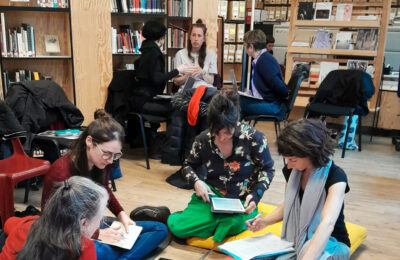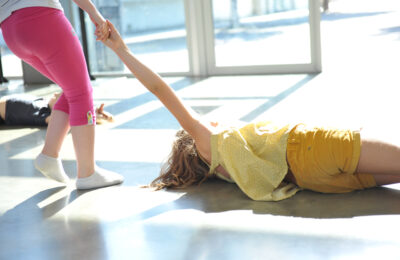To go further on “Trisha Brown, seen from the body”

With Denise Luccioni and Eva Karczag
An event organised by Contredanse in collaboration with Red Orange Productions, Danscentrumjette and Bozar for the opening night of the 11th international dancefilmfestival brussels l’art difficile de filmer la danse.
> More info on Trisha Brown
Speakers:
Denise Luccioni
Having worked in Paris at Artservice International with Bénédicte Pesle, then as curator at Théâtre de la Bastille, the American Center and Cartier Foundation…, assisting, producing, programming, writing, being an « outside eye » for many performing artists… Denise Luccioni focused on translating dance books and lecturing. She is now developing a series of audiovisual essays about personalities in the performing arts with whom she worked in various capacities since the 1970’s: Merce Cunningham, Steve Paxton, Benedicte Pesle, Richard Foreman, Grand Magasin, Philippe Quesne, Big Art Group, and Trisha Brown.
Eva Karczag
Since the early 1970s, Eva Karczag practices, teaches, and advocates for explorative methods of dance making. She performs solo and collaborative work internationally. She danced with the Trisha Brown Dance Company (1979-1985) and continues to teach through the company education program in New York and elsewhere. Her performing and teaching are both informed by dance improvisation and mindful body practices which engender trust in the body’s innate capacity for ease, efficiency and integrated openness.
Images and videos screened during the event:
Compass, Softground etching with relief roll, Trisha Brown, 2006.
Skymap, audio, the first two minutes of a 15 minute dance piece, 1969. Skymap “is an attempt to make a dance on the ceiling by verbal instructions to the audience to project words up to its surface,” Sally Banes wrote in Terpsichore in Sneakers, and she publishes the whole text at the end of her chapter about Trisha Brown (titled “Gravity and levity“).
Primary Accumulation, 1973, an excerpt of a video by Carlotta Schoolman. Trisha Brown’s comments come from a seminar in Paris, in the fall of 1989.
Trisha Brown, photo Wendy Perron, Bennington College, ca. 1980.
Gestures from the archive, Cori Olinghouse, 2016, edited by Stuart Shugg. A dream of a visual guided tour through Trisha Brown’s career. A-chronologically, it shows processes, leitmotivs and developments in Trisha Brown’s unique language.
Trisha Brown, a brief audio excerpt from a 2010 conversation.
Pure Movement, Trisha Brown wrote this statement to accompany the lecture- demonstrations of Locus (1975). Wendy Perron used to read it. This is a 2014 recording.
Game by Stephen Petronio, a contribution to Trisha Brown from A to Z (a work-in-progress, Denise Luccioni).
Off-kilter by Lisa Kraus, ditto.
Shot Backstage,1998, Camera by Trisha Brown. Music by Alvin Curran / Edited by Steve Hamilton.Trisha Brown filmed For M.G.: The Movie (1991) from the wings: a skew vision, an attention to detail, all her senses concentrated in her eyes, a sensorial camera work.
The Running Solo, audio, Diane Madden, read by Diane Madden (2022). The text was first published by Contact Quarterly in 1995.
Spiral, excerpt, with added laugh from a 2010 conversation.
Trisha Brown laughing, Steve Paxton must have said something funny: photo Tyler Resch, Bennington College Judson Project c. 1981. This project was designed and organised by Wendy Perron, who was teaching at Bennington at the time.
The excerpts from Primary Accumulation and Spiral come from the DVD Early Works, an Artpix/Notebooks.
To see more drawings of Trisha Brown’s: https://www.sikkemajenkinsco.com/trisha-brown
Many thanks to Adam Martell Brown; Cori Olinghouse for Gestures from the Archive, the Trisha Brown Dance Company for material from the Trisha Brown Archives, Lisa Kraus and Stephen Petronio for their filmed keywords, Wendy Perron for her reading, and sharing photos, and Diane Madden for her text and reading.
Artist, archivist, and curator Cori Olinghouse danced in the Trisha Brown company from 2002 through 2006, before operating as archive director for the company and assisting in the legacy planning for the company and archive (2009-2018). She develops an independent activity based on a creative use of archive, curating, teaching, making.
> https://theportal.place/about/
A statement: “Embodiment is the idea that knowledge is grounded in sensory and lived experience. While the concept is used differently across contexts, it tends to involve a frustration with binary constructs such as mind/body, subject/object, and knower/known. Instead, it suggests that cognition is shaped by the entire organism, including its situated and social point of view.”
Wendy Perron is a dancer/choreographer turned writer/editor/scholar. She trained equally in modern dance and ballet before earning a B.A. from Bennington College and an M.A. from SUNY Empire State College. She danced with the Trisha Brown Company in the 1970s and choreographed more than 40 works for her own group, which received commissions from Lincoln Center Festival, the Joyce Theater, Jacob’s Pillow, and the Danspace Project. Perron has taught at Bennington College, Princeton University, and New York University’s Tisch School of the Arts. In the early 1990s she served as Associate Director of Jacob’s Pillow Dance Festival, where she conceived and co-directed an international intensive in improvisation. She has written for the New York Times, the Village Voice, vanityfair.com, SoHo Weekly News, David Zwirner Books, and journals in Europe and China. From 2004 to 2013, she was the editor in chief of Dance Magazine. An authority on Judson Dance Theater and postmodern dance, Perron has lectured internationally and has curated several exhibits on these topics. In 2011 she was the first dance artist to be inducted into the New York Foundation for the Arts’ Hall of Fame. Her book, The Grand Union: Accidental Anarchists of Downtown Dance, 1970-1975, met with acclaim when it was published in 2020. She has recently performed with Yoshiko Chuma and the School of Hard Knocks. Since 2019 she has been teaching Dance History at the Juilliard School.
Greatly influenced by working with Steve Paxton, Stephen Petronio was the first male dancer of the Trisha Brown Dance Company (1979 to 1986). He has gone on to build a unique career, with the company he founded in 1984, receiving numerous accolades.
Petronio, whose training originated with leading figures of the Judson era, performed Man Walking Down the Side of a Building in 2010 for Trisha Brown Company at the Whitney Museum, and his 2012 rendition of Steve Paxton’s Intravenous Lecture(1970) in New York, Portland, Washington D.C…
Lisa Kraus danced with Trisha Brown from 1977 to 1982, and later set Brown’s dances on other companies. She has written widely about dance, taught at EDDC in Arnhem for many years (now ArtEZ), curated the Bryn Mawr College Performing Arts Series, and founded thINKingDANCE (thinkingdance.net), which is dedicated to critical coverage of dance.
> https://trishabrown.brynmawr.edu/overview-history
Since 1980, Diane Madden has danced, directed, taught, studied and reconstructed Trisha Brown’s work. She originated many roles in Brown’s work, and was awarded a New York Dance and Performance “Bessie” Award for Astral Convertible (1989). Madden was Company Rehearsal Director from 1984-2000 then taught and directed special projects for the Company before serving again as Rehearsal Director from 2010 until 2013, when she was named Associate Artistic Director. Since 2019 she lives in Brussels, teaches and tutors at P.A.R.T.S. and is one of Rosas’ Rehearsal Directors. She continues to serve the Trisha Brown Company as Artistic Consultant. In addition to her own performance work in collaborative improvisational forms, she is greatly influenced by her study and practice of Aikido with Fuminori Onuma.
If you have questions, please send email or voice message via email to: askmeaboutTB@gmail.com.
You can write in English, French, or Flemish, and you will receive an answer in writing or a voice file in an email.
Denise Luccioni secretly dedicates this evening to David Gordon (1936-2022), particularly for his inspiring “Archiveography.” http://davidgordon.nyc
Other events and articles that may interest you

Les liens de la danse. Un groupe de recherche anthropologique en résidence à Contredanse

NDD#89 – Plongée en enfance. Du regard à la pratique

